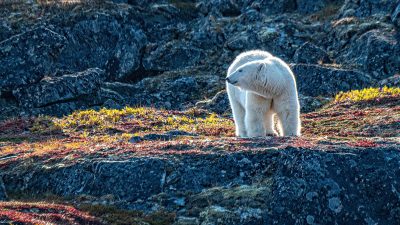Video | Destinations
Top of the World: L’Anse aux Meadows Viking Settlement
By Adventure Canada | January 14, 2022
Related expedition: Newfoundland Circumnavigation and Greenland & Wild Labrador: A Torngat Mountains Adventure
Video | Destinations
By Adventure Canada | January 14, 2022
Related expedition: Newfoundland Circumnavigation and Greenland & Wild Labrador: A Torngat Mountains Adventure
On the northern tip of Newfoundland lies a place that was forgotten for centuries, except in the pages of Iceland's old Norse Sagas. Welcome to L'Anse aux Meadows, the first authenticated Viking settlement on the North American continent, circa 1000 AD.
Among their travels from Scandinavia to continental Europe, Russia, and the Mediterranean Sea, the Vikings also ended up in Canada nearly five hundred years before Columbus reached the Caribbean islands.
Although northern Newfoundland is no tropical paradise, for the Vikings, who were used to the rocky North Atlantic islands, it suited them just fine. After all, on the shores of the Strait of Belle Isle, they found game to hunt, fish to catch, and grass for grazing their livestock.
It's unsurprising that these seafarers should have sailed from Iceland and Greenland to what is now Newfoundland. But until 1962, the only evidence they had done so was in the text of the Icelandic Sagas.
These ancient volumes about Viking voyages and adventures, written hundreds of years ago based on oral tradition, include plenty of embellishment and tall tales. But some of those tall tales are true. The Sagas mentioned Vikings making landfall in a place they called Vinland, often translated as "wine country".
This led archaeologists to believe that the Vikings may have landed somewhere grapes were grown. Others conjectured Vinland may have referred to pasture land, or even just a place with access to berries. Either way, the word of the Sagas was unsupported by any archaeological evidence until 1962.
That's when explorer Helge Ingstad and archaeologist Anne Stine Ingstad travelled the coast of Newfoundland, seeking clues based on their readings of the Saga of the Greenlanders and the Saga of Erik the Red.
After months of questioning, they were led by a local to L'Anse aux Meadows. While there, they found overgrown rectangles by Epaves Bay. This is where Helge and Anne began a year long excavation.
During the excavation, they discovered the foundations of eight houses and several valuable objects. These included cooking pits, a smithy, handmade iron nails, a spindle, a bronze ring pin, and the husks of butternuts.
These objects may sound meaningless, but they've provided considerable value in the history of Vikings in North America. The bronze ring pin strongly suggests the structures weren't built by the Indigenous peoples of Newfoundland, but the Vikings.
Some historians believe L'Anse aux Meadows was a staging area for Vikings to meet up and gather supplies, where they would then travel further down south to trade with the locals. But certainly not all interactions with locals went well.
The Sagas record skirmishes with a people the Vikings called Skraelings, with casualties on both sides. It's possible these negative interactions discouraged further settlement in North America.
The Viking settlement in Newfoundland did not last long, perhaps as little as ten years. The Sagas record what became of some of its settlers, including the remarkable woman known as Gudrid the Far-Traveller and her son Snorri, who was said to have been the first European born in North America.
What has remained is the mystery. How far did the Vikings reach in their epic voyages, and how much of what the Sagas record is true and just waiting to be rediscovered?

October 1 to October 12, 2025
From $6,995 to $15,295 USD
per person based on double occupancy
Save 10%

September 11 to September 22, 2026
From $9,595 to $19,595 USD
per person based on double occupancy

September 17 to October 1, 2025
From $9,495 to $19,095 USD
per person based on double occupancy
Save 15%

September 27 to October 11, 2026
From $15,995 to $24,195 USD
per person based on double occupancy

August 28 to September 11, 2026
From $11,995 to $22,795 USD
per person based on double occupancy